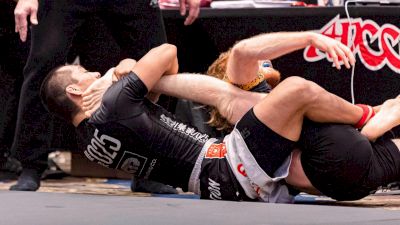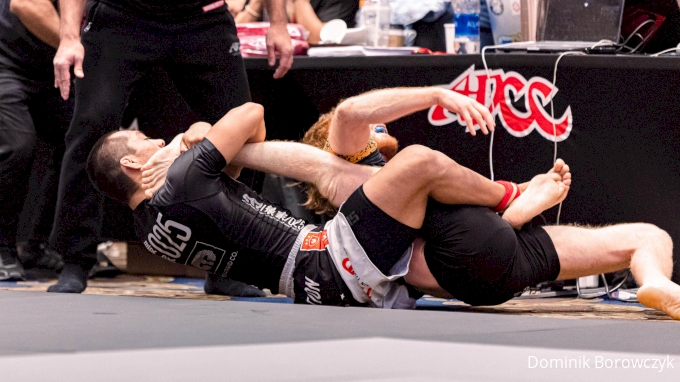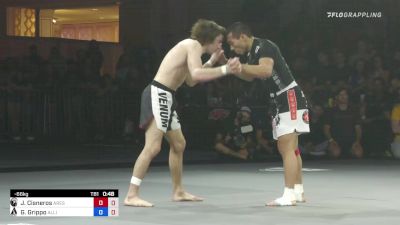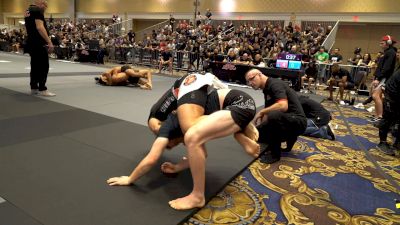The Suloev Stretch at ADCC Trials: What Is It and How Does It Work?
The Suloev Stretch at ADCC Trials: What Is It and How Does It Work?
Josh Cisneros hit not one but two of the most stunning leg attacks you could hope to see at ADCC Trials– MMA fans will recognize it as the Suloev stretch.

The ADCC West Coast Trials saw many shocking submissions but the newly christened “Cisneros stretch” was maybe the most spectacular.
66kg silver medalist Josh Cisneros hit not one but two of the most stunning leg attacks you could hope to see. MMA fans will recognize it as the Suloev stretch, a visceral and hyper graphic attack that is incredibly powerful. The submission has a rich and interesting history that we’ll break down below before explaining how it works.

The History of The Suloev Stretch
Named after Amar Suloev, a Russian MMA fighter, the Suloev stretch is an unorthodox leg submission occasionally seen in MMA fights and grappling matches.
Amar Suloev’s MMA career began in 1999. With a background in kickboxing and wrestling, Suloev competed in bare-knuckle events in Russia and Brazil and quickly established himself as a dangerous fighter both on the feet and on the mat. In 2002 he twice fought in the UFC, losing a decision to future light heavyweight champion Chuck Liddell.
In 2002, his first fight after leaving the UFC was a rematch with British brawler Paul Cahoon. Suloev submitted Cahoon in only 63 seconds with the submission that would go on to bear his name.
The name “Suloev stretch” did not enter common parlance until 2013, when MMA journalist KJ Gould coined the term following Kenny Robertson‘s win versus Brock Jardine at UFC 157. Until then, MMA fans and writers had struggled to properly identify the attack, often referring to it as a kneebar or hamstring stretch.
Suloev retired from MMA in 2008 and became involved with organized crime in Russia. He was jailed after being accused of acting as a hitman for the Russian mob, but was released after being diagnosed with stomach cancer. Suloev died in 2016 at the age of 40.
The submission exploded into the public consciousness two years after Suloev’s death. Both Aljamain Sterling and Zabit Magomedsharipov won fights using the submission at UFC 228, introducing a generation of viewers to the once-exotic attack and cementing “Suloev stretch” as the now-official name for the submission.
How the Suloev Stretch Works
As you can imagine based on the name, the Suloev stretch is not a joint lock. It involves pulling on an opponent’s leg in such a way that it takes the hamstring muscles to the limits of their flexibility.
A very painful submission attack, it can cause serious injury by tearing the muscles in the back of the thigh. The Suloev stretch also affects the hip and knee of the isolated leg– some pressure is applied through the hyperextended knee joint much like a kneebar, while the rotational limit of the hip joint is put under stress due to the leg’s extreme position in relation to the torso.
Joshua Cisneros Submits Gianni Grippo with Suloev Stretch

The Suloev stretch is initiated when an attacker is controlling his opponent from the back, usually securing a seatbelt grip around the upper body and either one or both hooks or a body triangle around the lower torso.
The most common set-up comes when the defender has his hands and feet on the floor and elevates his hips. The attacker will grab one of the ankles of his opponent and pull it towards the upper body. This elongates the hamstring group of muscles in the back of the thigh, causing great pain and possible muscle damage if not released.
The Cisneros Stretch
A lifelong practitioner of both wrestling and jiu-jitsu, Josh Cisneros combines elements of both grappling arts when he competes in no-gi competition.
In wrestling, a leg rider is somebody who controls his opponent from behind with one or both hooks. It is not uncommon for wrestlers to use the Suloev stretch to off-balance and turn their opponents and sometimes even pin them, although it is not permitted to use the movement to threaten a potential injury like in a jiu-jitsu or grappling match.
What's surprising is that Cisneros had never hit the move in competition until ADCC West Coast Trials.
"That leglock, honestly I just pulled it out for the first time this weekend," says Cisneros. "It’s something you can’t really practice unless you’re really careful with your partner. I’ve done it in training before but it’s one of those moves where it instantly snaps before you even have time to react.
"It stretches the hamstring and puts an enormous tension on it to tear it. So Gianni and the other guy, when I hit that move I literally felt their hamstrings tearing. It was just an instant tear as soon as it’s extended."
In the clip below you can see Cisneros disrupt the balance of his opponent by securing control of one ankle before actively tilting himself off to the side to knock them to the mat. Once they no longer have both feet on the mat, it is easier for him to pull the leg and force the submission.
Josh Cisneros Finishes Opponent with Brutal Suloev Stretch

In mixed martial arts the name Suloev stretch is now firmly engrained as the official moniker for this technique. We jokingly called it the Cisneros stretch after he hit it twice in a row at the ADCC West Coast Trials in Las Vegas, and while we don’t expect grapplers to adopt this name for a technique that is becoming increasingly common, it will be hard to forget the time that Cisneros scored two of the most impressive submissions in ADCC history.